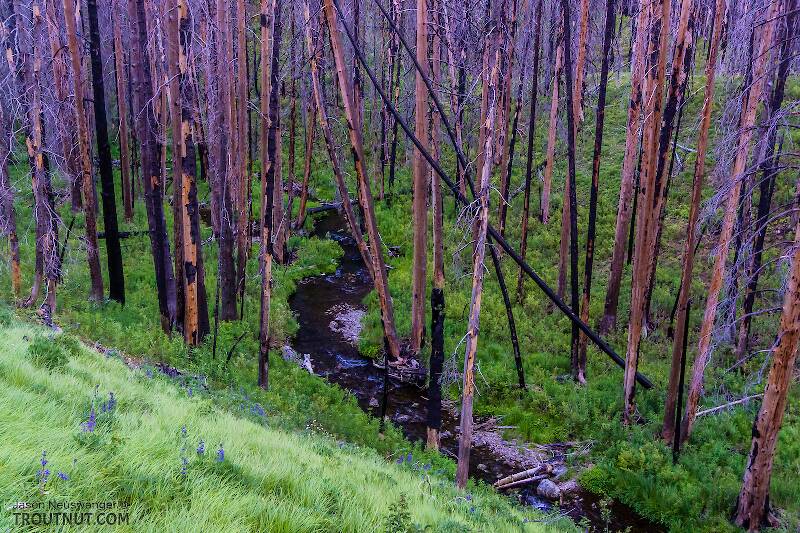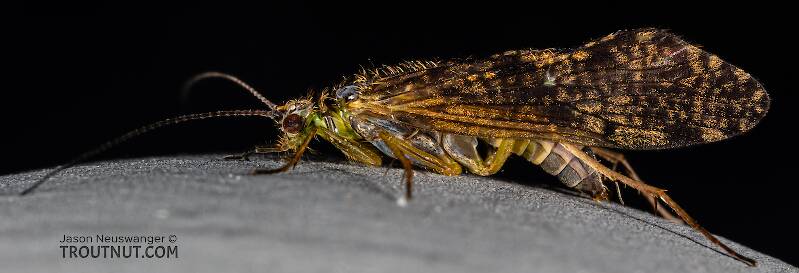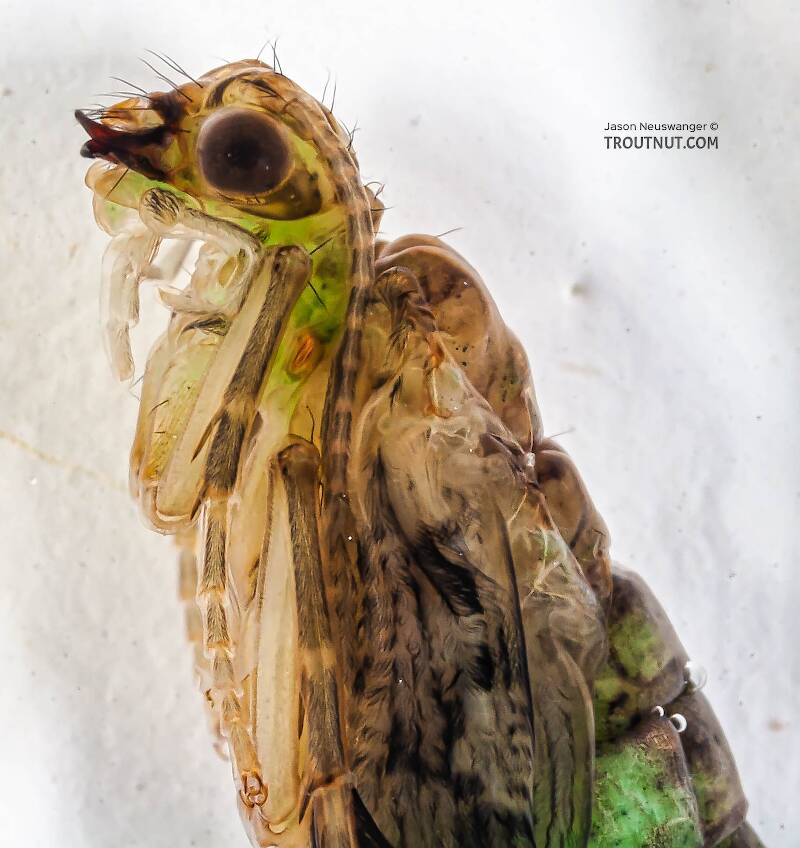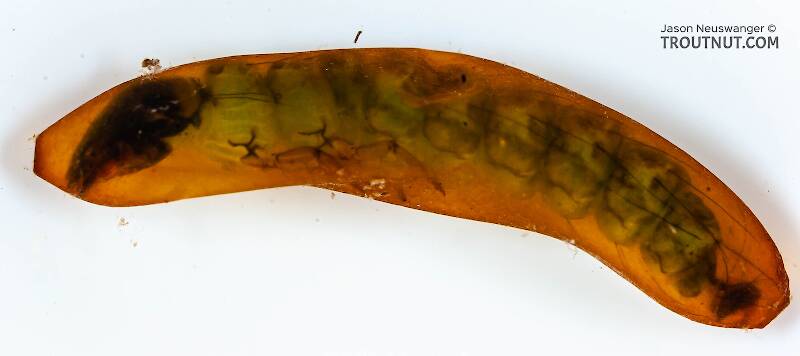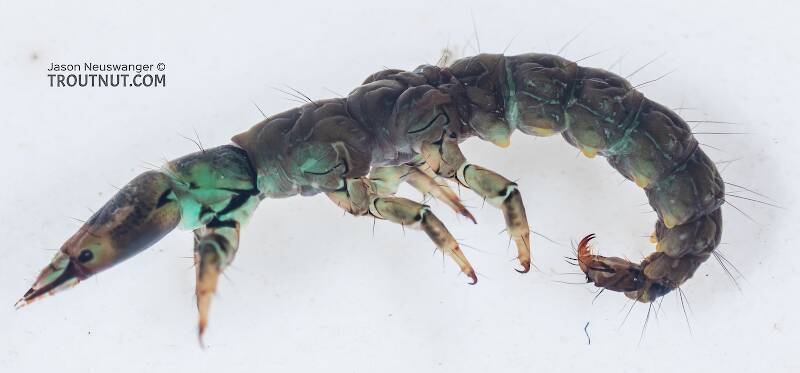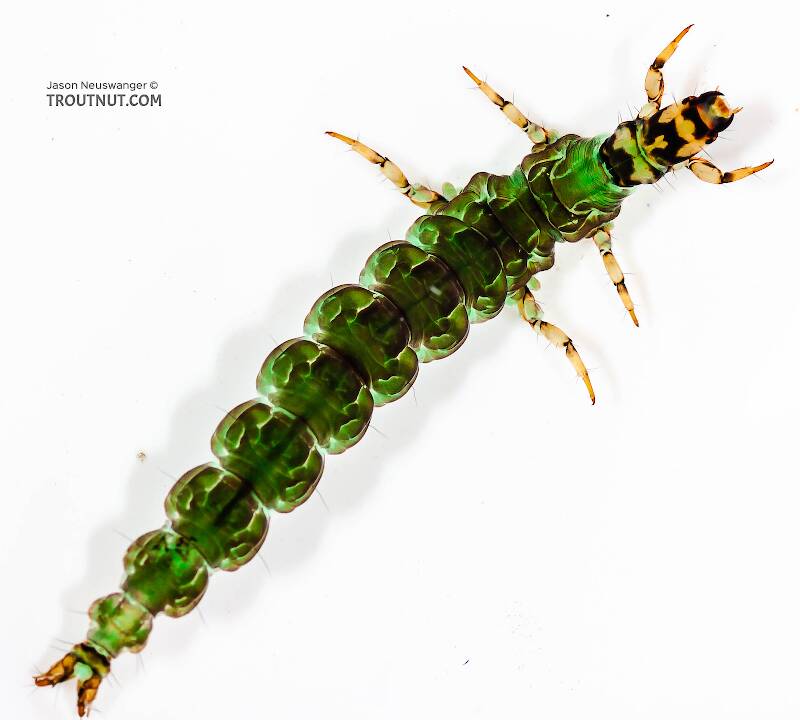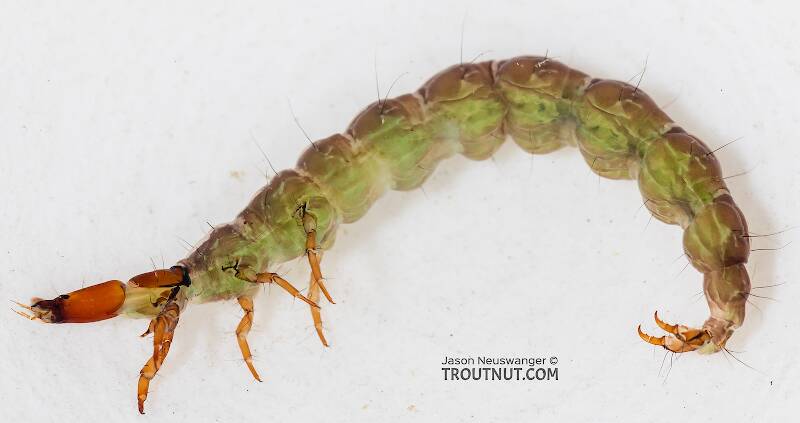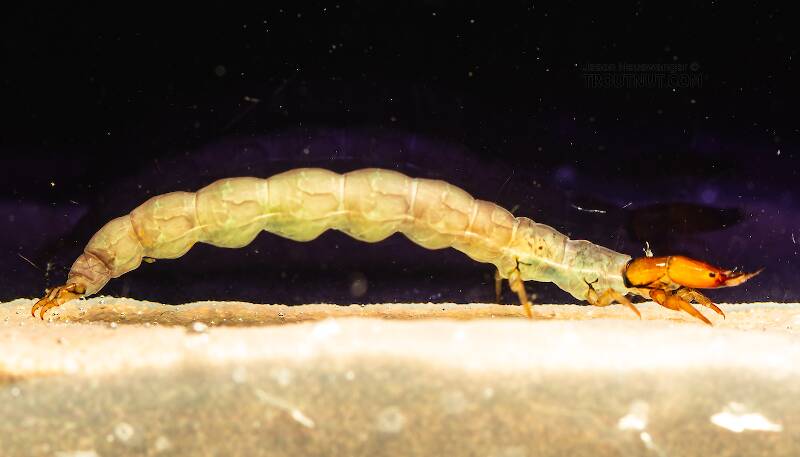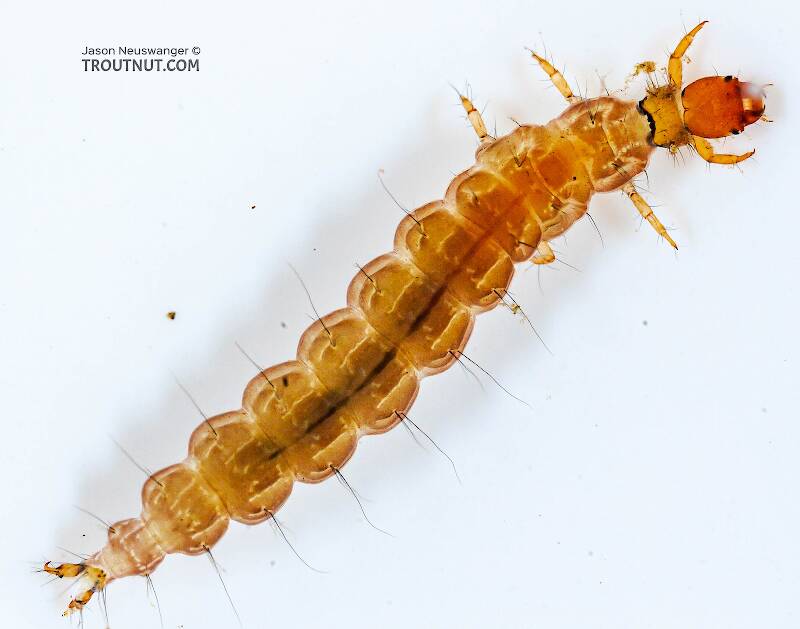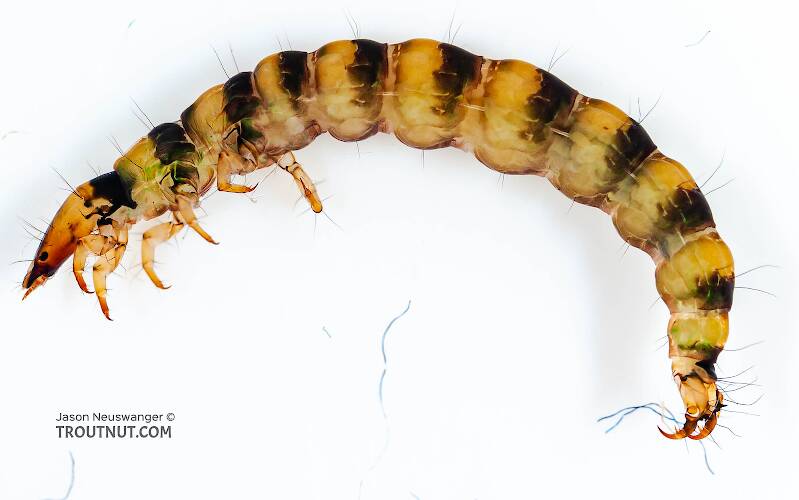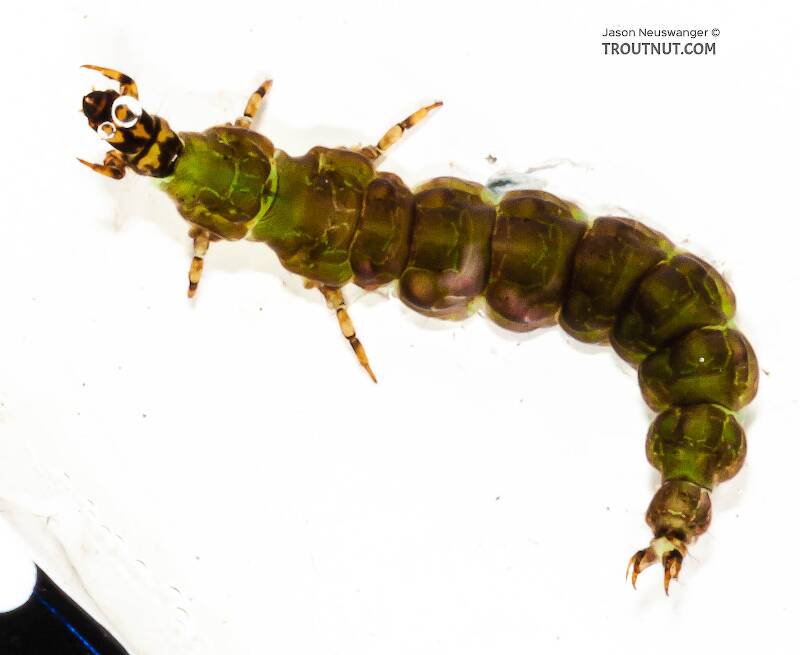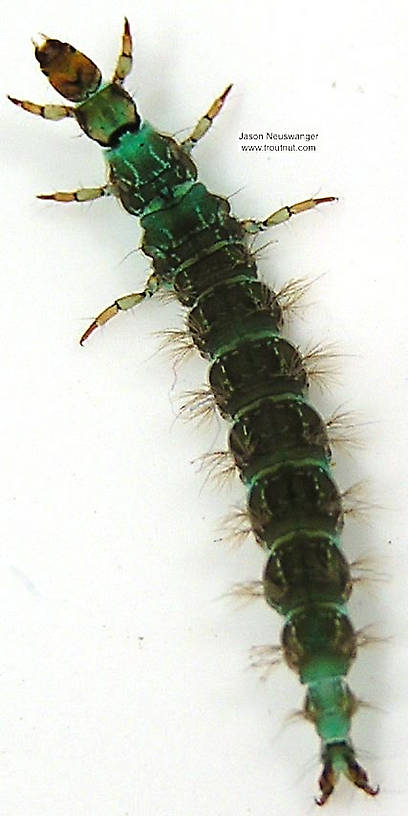
Salmonflies
Pteronarcys californica
The giant Salmonflies of the Western mountains are legendary for their proclivity to elicit consistent dry-fly action and ferocious strikes.
Featured on the forum

This one seems to tentatively key to Holocentropus, although I can't make out the anal spines in Couplet 7 of the Key to Genera of Polycentropodidae Larvae nor the dark bands in Couplet 4 of the Key to Genera of Polycentropodidae Larvae, making me wonder if I went wrong somewhere in keying it out. I don't see where that could have happened, though. It might also be that it's a very immature larva and doesn't possess all the identifying characteristics in the key yet. If Holocentropus is correct, then Holocentropus flavus and Holocentropus interruptus are the two likely possibilities based on range, but I was not able to find a description of their larvae.

Troutnut is a project started in 2003 by salmonid ecologist Jason "Troutnut" Neuswanger to help anglers and
fly tyers unabashedly embrace the entomological side of the sport. Learn more about Troutnut or
support the project for an enhanced experience here.
Caddisfly Genus Rhyacophila (Green Sedges)
The large free-living larvae of the Rhyacophila genus are among the best-known caddisflies, and for good reason, because their unique biology is both interesting to entomologists and compatible with trout fishing. There are over 100 species, and many of them can be important.
Where & when
In 1213 records from GBIF, adults of this genus have mostly been collected during June (24%), July (21%), May (19%), August (17%), September (7%), and April (5%).
In 610 records from GBIF, this genus has been collected at elevations ranging from 10 to 23622 ft, with an average (median) of 3652 ft.
Genus Range
Hatching behavior
Habitat: Riffles
Egg-Laying behavior
Habitat: Riffles
Larva & pupa biology
Diet: For most species, other aquatic insects.
Current speed: Fast
Environmental tolerance: Most species require cool water
Shelter type: No case
Many of these larvae have no gills at all and rely on absorbing oxygen from the water through their skin. Only cold water and fast flows can meet these needs, so Rhyacophila caddisflies love the same habitat as trout.
The larvae may rappel between the rocks on a line of brown silk they secrete. This can be imitated by coloring the last foot or so of one's leader with a brown marker.
Identification
To determine whether a specimen of Rhyacophilidae belongs to Rhyacophila, use the Key to Genera of Rhyacophilidae Adults.
Rhyacophila Fly Fishing Tips
Gary LaFontaine wrote some good tips in Caddisflies about fishing appropriate flies for the water you're covering:A good imitaiton of a Rhyacophila larva is going to catch a lot of trout in swift, bouncing stretches of stream. The same fly is going to do poorly in slow areas of the same stream.
A fly fisherman can avoid wasting time in the wrong sections of a stream by working leap-frog fashion instead of in a straight line. If he is using an imitaiton of a fast-water insect he should fish only the swift, broken currents, skipping past the slower current areas. Likewise, if he is using an imitation of a slow-water insect he should only cover the quieter pools and flats.
He was speaking about fishing Rhyacophila imitations, but the advice is equally applicable to many aquatic insects. He cautions against using these imitations where the real insects are not abundant in the drift, because they are otherwise too large and bright to seem realistic.
Specimens of the Caddisfly Genus Rhyacophila
1 Adult
3 Pupae
9 Larvae
Start a Discussion of Rhyacophila
References
- LaFontaine, Gary. 1981. Caddisflies. The Lyons Press.
- Schwiebert, Ernest G. 1955. Matching the Hatch. MacMillan Publishing Company.
- Swisher, Doug and Carl Richards. 2000. Selective Trout. The Lyons Press.
Caddisfly Genus Rhyacophila (Green Sedges)
Taxonomy
Species in Rhyacophila
Rhyacophila angelita
0
0
Rhyacophila basalis
0
0
Rhyacophila bifila
0
0
Rhyacophila brunnea
1
4
Rhyacophila carolina
1
10
Rhyacophila coloradensis
0
0
Rhyacophila fenestra
0
0
Rhyacophila fuscula
2
22
Rhyacophila glaberrima
0
0
Rhyacophila grandis
0
0
Rhyacophila lobifera
0
0
Rhyacophila mainensis
1
10
Rhyacophila manistee
0
0
Rhyacophila narvae
0
0
Rhyacophila pellisa
0
0
Rhyacophila torva
0
0
Rhyacophila vaccua
0
0
Rhyacophila verrula
0
0
Rhyacophila vocala
1
11
Species in Rhyacophila: Rhyacophila angelita, Rhyacophila basalis, Rhyacophila bifila, Rhyacophila brunnea, Rhyacophila carolina, Rhyacophila coloradensis, Rhyacophila fenestra, Rhyacophila fuscula, Rhyacophila glaberrima, Rhyacophila grandis, Rhyacophila lobifera, Rhyacophila mainensis, Rhyacophila manistee, Rhyacophila narvae, Rhyacophila pellisa, Rhyacophila torva, Rhyacophila vaccua, Rhyacophila verrula, Rhyacophila vocala
119 species (Rhyacophila accola, Rhyacophila acutiloba, Rhyacophila alabama, Rhyacophila alberta, Rhyacophila alexanderi, Rhyacophila amabilis, Rhyacophila amicis, Rhyacophila appalachia, Rhyacophila arcella, Rhyacophila ardala, Rhyacophila arnaudi, Rhyacophila atrata, Rhyacophila autumnalis, Rhyacophila balosa, Rhyacophila banksi, Rhyacophila belona, Rhyacophila betteni, Rhyacophila blarina, Rhyacophila bruesi, Rhyacophila californica, Rhyacophila carolae, Rhyacophila carpenteri, Rhyacophila cerita, Rhyacophila chandleri, Rhyacophila chilsia, Rhyacophila chordata, Rhyacophila colonus, Rhyacophila complicata, Rhyacophila darbyi, Rhyacophila doddsi, Rhyacophila donaldi, Rhyacophila ebria, Rhyacophila ecosa, Rhyacophila fenderi, Rhyacophila formosa, Rhyacophila gemona, Rhyacophila glaciera, Rhyacophila haddocki, Rhyacophila harmstoni, Rhyacophila hyalinata, Rhyacophila inculta, Rhyacophila insularis, Rhyacophila invarius, Rhyacophila iranda, Rhyacophila jenniferae, Rhyacophila jewetti, Rhyacophila karila, Rhyacophila kernada, Rhyacophila kiamichi, Rhyacophila kincaidi, Rhyacophila kondratieffi, Rhyacophila latitergum, Rhyacophila ledra, Rhyacophila leechi, Rhyacophila lineata, Rhyacophila lurella, Rhyacophila malkini, Rhyacophila milnei, Rhyacophila minora, Rhyacophila montana, Rhyacophila mosana, Rhyacophila mycta, Rhyacophila neograndis, Rhyacophila nevadensis, Rhyacophila newelli, Rhyacophila nigrita, Rhyacophila norcuta, Rhyacophila novarotunda, Rhyacophila ophrys, Rhyacophila oregonensis, Rhyacophila oreia, Rhyacophila oreta, Rhyacophila otica, Rhyacophila pacifica, Rhyacophila parantra, Rhyacophila pennsylvanica, Rhyacophila perda, Rhyacophila perplana, Rhyacophila pichaca, Rhyacophila potteri, Rhyacophila rayneri, Rhyacophila reyesi, Rhyacophila rickeri, Rhyacophila robusta, Rhyacophila rotunda, Rhyacophila sequoia, Rhyacophila shenandoahensis, Rhyacophila sibirica, Rhyacophila sierra, Rhyacophila siskiyou, Rhyacophila soror, Rhyacophila spinata, Rhyacophila starki, Rhyacophila tamalpaisi, Rhyacophila teddyi, Rhyacophila tehama, Rhyacophila tralala, Rhyacophila tucula, Rhyacophila unimaculata, Rhyacophila unipunctata, Rhyacophila vaefes, Rhyacophila vagrita, Rhyacophila valuma, Rhyacophila vao, Rhyacophila vedra, Rhyacophila velora, Rhyacophila vemna, Rhyacophila vetina, Rhyacophila vibox, Rhyacophila vinura, Rhyacophila viquaea, Rhyacophila visor, Rhyacophila vobara, Rhyacophila vofixa, Rhyacophila vu, Rhyacophila vujuna, Rhyacophila vuzana, Rhyacophila wallowa, and Rhyacophila willametta) aren't included.

